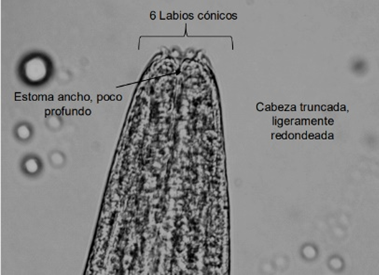Isolation and identification of native entomopathogenic nematodes in different land use systems in Yurimaguas
DOI:
https://doi.org/10.56926/repia.v1i1.9Keywords:
biologic control, Heterorhabditis, agrarian soil system, SteinernemaAbstract
Within biotic communities, nematodes are important environmental indicators of conservation of agricultural soil systems. The objective of the study was to isolate and identify nematodes in 10 land use systems of the Yurimaguas district, Peru. The collection of samples from each soil system was random, 10 soil samples, collected from an approximate depth of 15 cm, later the isolation of the samples was carried out in sterilized containers, where they were divided into two subsamples for the placement of 5 to 10 moth larvae (G. mellonella), which were kept in environments between 20 and 25 °C for one week; After the incubation period, the presence of entomopathogenic nematodes was evaluated. The presence of nematodes of the genus Heterorhabditis and Steinernema was found in land use systems of cocoa (Theobroma cacao L), cassava (Manihot esculenta) and plantain (Musa paradisiaca) crops. The identification study of native entomopathogenic nematodes in the different land uses of Yurimaguas contributes as a proposal for the biological control of pests in crops of economic importance.
Downloads
References
Basilio Agui, E. B. (2018). Aislamiento e identificación de nematodos entomopatógenos en el distrito de Yanahuanca-Daniel Carrión. Universidad Nacional Daniel Alcides Carrión.
Bertolotti, M. A., & Cagnolo, S. R. (2019). Nematodos entomopatógenos (familias Steinernematidae y Heterorhabditidae) en Argentina. Recopilación de hallazgos de poblaciones naturales en medio siglo de prospecciones. Revista Facultad de Ciencias Exactas, Físicas y Naturales, 6(1). https://revistas.unc.edu.ar/index.php/FCEFyN/article/view/21082
Bustamante García, V. (2020). Estudio de la ocurrencia de nematodos en el cultivo de cacao (Teobroma cacao L) en la zona sur de la provincia del Guayas. Alternativas, 20(1). https://doi.org/10.23878/alternativas.v20i1.280
Ferrer Wurst, F. (2021). Control biológico de plagas agrícolas en Venezuela: los logros históricos de la empresa Servicio Biológico (SERVBIO). Revista de Ciencias Ambientales, 55(1), 327–344. https://doi.org/10.15359/rca.55-1.16
Islas-lópez, G., Torres-huerta, B., & Rosalía, A. (2021). Identificacion de nematodos entomopatogenos con potencial para el manejo de Dendroctonus frontalis (Curculionidae : scolytinae). Interciencia: Revista de Ciencia y Tecnología de América, 46(August), 296–301.
Kaya, H. K., & Stock, P. S. (1997). Techniques in insect nematology. In Manual of Techniques in Insect Pathology (pp. 281–324). https://doi.org/10.1016/B978-012432555-5/50016-6
López-Llano, R. A., & Soto-Giraldo, A. (2016). Aislamiento de nematodos entomopatógenos nativos en cultivos de caña panelera y pruebas de patogenicidad sobre Diatraea saccharalis (Lepidoptera: Crambidae). Boletin Cientifico Del Centro de Museos, 20(2), 114–123. https://doi.org/10.17151/bccm.2016.20.2.8
Maximiliano Orbegoso, M. A. (2014). Aislamiento y Multiplicación de Nematodos Entomopatógenos en Trujillo – La Libertad. Universidad Nacional de Trujillo.
Pacheco Hernández, M. de L., Reséndiz Martínez, J. F., & Arriola Padilla, V. J. (2019). Organismos entomopatógenos como control biológico en los sectores agropecuario y forestal de México: una revisión. Revista Mexicana de Ciencias Forestales, 10(56). https://doi.org/10.29298/rmcf.v10i56.496
Paez Cuervo, M. D. (2019). Aislamiento de nemátodos entomopatogenos presentes en ecosistemas de palma aceitera en la zona oriental y suroccidental de Colombia. Universidad de Cundimarca.
Parada Domínguez, O., Alatorre Rosas, R., Guzmán Franco, A. W., Hernández Rosas, F., Rojas Avelizapa, L. I., & Ruíz Vera, V. M. (2019). Efecto de nematodos entomopatógenos en ninfas de Aeneolamia albofasciata y su persistencia en suelos cañeros de Veracruz. Revista Mexicana de Ciencias Agrícolas, 22, 115–127. https://doi.org/10.29312/remexca.v0i22.1863
Sánchez-Moreno, S., & Talavera, M. (2013). Los nematodos como indicadores ambientales en agroecosistemas. Ecosistemas, 22(1), 50–55. https://doi.org/10.7818/ECOS.2013.22-1.09
Sánchez Jara, J., Valle Delgado, J., Pérez Tesén, E., Neira de Perales, M., & Calderón Arias, C. (2019). Control biológico de Spodoptera frugiperda en cultivo de Zea mays: Uso de nematodos entomopatógenos. Scientia Agropecuaria, 10(4), 551–557. https://doi.org/10.17268/sci.agropecu.2019.04.12
Varela Benavides, I. (2018). Abundancia, diversidad y huella metabólica de comunidades de nematodos en diferentes zonas de vida en la Región Huetar Norte de Costa Rica. Revista de Biología Tropical, 66(4), 1709–1720. https://doi.org/10.15517/rbt.v66i4.33219

Published
How to Cite
Issue
Section
License
Copyright (c) 2022 Marco Antonio Mathios-Flores, Beto Pashanasi-Amasifuén, Analy Nohely Aponte-Jaramillo, Jesús Guillermo Alcázar-Sedano, Luis Alejandro Saire-Quispe

This work is licensed under a Creative Commons Attribution 4.0 International License.
Authors retain their rights:
a. The authors retain the intellectual property rights (copyright) of the published works, assigning to the journal the right of first publication.
b. Authors retain their trademark and patent rights, and also on any process or procedure described in the article.
c. Authors retain the right to share, copy, distribute, perform and publicly communicate the article published in REPIA (e.g., place it in an institutional repository or publish it in a book), with an acknowledgement of its initial publication in REPIA.
d. Authors retain the right to make a subsequent publication of their work, to use the article or any part of it (e.g., a compilation of their work, notes for conferences, theses, or for a book), provided they indicate the source of publication (authors of the work, journal, volume, number, and date).







